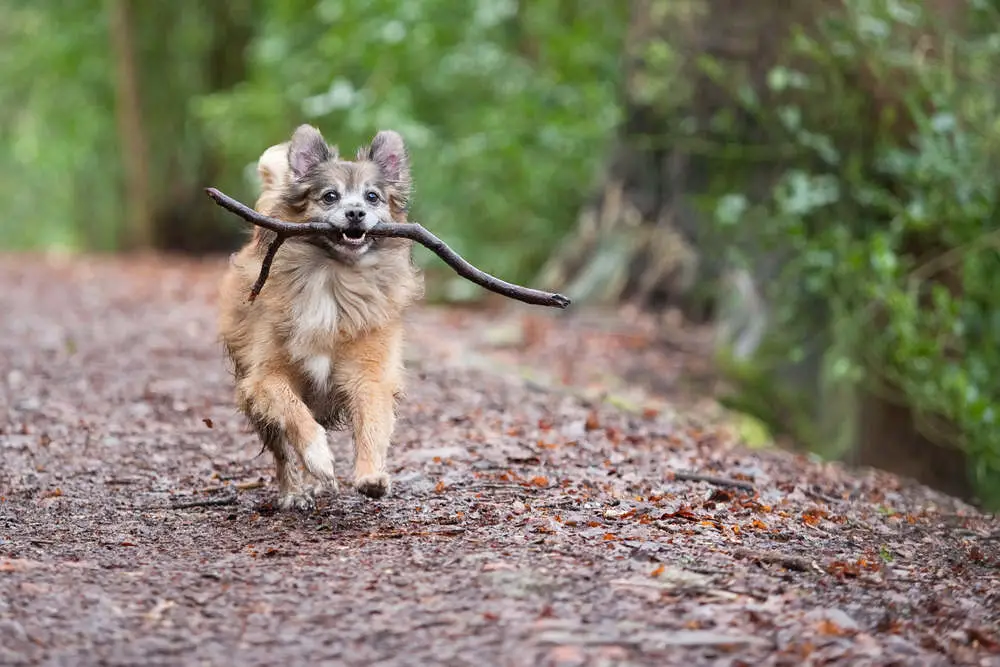
Have you ever noticed your furry friend’s obsession with sticks? You’re not alone. Many dog owners find themselves puzzled by their canine companion’s strong attraction to these seemingly mundane objects. In this article, we’ll explore some of the reasons behind why dogs like sticks.
One reason is the natural instinct that drives dogs to be drawn to sticks. This instinct harkens back to their ancestral days when they were hunters and foragers. Sticks closely resemble bones, which their wild counterparts would often gnaw on for nutrition and entertainment. Additionally, the unique texture and natural scent of sticks provide a stimulating and sensory experience for your dog, making these objects an attractive chew toy.
Another factor that contributes to dogs’ love for sticks is their innate sense of playfulness. Sticks are readily available and versatile, allowing them to engage in various forms of play, such as fetching, tossing, and chewing. This helps your dog to work off pent-up energy and provides essential mental stimulation, ultimately making them feel more content and in touch with their doggy instincts.
Historical and Evolutionary Background
Natural Behavior and Domestication
Dogs were once wild animals, closely related to wolves. They were hunter-foragers, relying on their instincts to survive. Over time, as humans and dogs began to live side by side, these wild animals eventually became domesticated. As their roles shifted, they started to develop new behaviors to better adapt to living with humans.
Yet, even though your modern dog may be domesticated, it’s essential to remember that they still carry traces of their wild ancestry. For instance, dogs are naturally attracted to sticks, which can be explained by their deep-rooted instincts. Discovering why dogs like sticks could help you understand your furry friend’s behavior.
Hunting Instincts and Prey Drive
In the wild, the ancestors of today’s domesticated dogs relied heavily on their hunting instincts and prey drive to secure food. These instincts, vital for survival in the past, continue to be a strong influence in modern domestic dogs.
The appeal of sticks to dogs can be partially attributed to these ingrained hunting instincts. When a dog interacts with a stick, it may be reminiscent of a small animal’s bone, triggering their natural predatory behaviors. This fascination with sticks is a manifestation of their ancestral traits, echoing the behaviors of their wild counterparts.
Understanding your dog’s natural behaviors and evolutionary background can offer insights into their interest in sticks. While the context of these instincts has changed due to domestication, they still play a significant role in the daily life of your dog. Observing your canine companion playing with a stick, you’re witnessing a part of their ancestral heritage in action.
Psychological and Behavioral Reasons
Mouth and Chewing Satisfaction
One reason dogs enjoy sticks is because they offer mouth and chewing satisfaction. Chewing on sticks provides a pleasant texture that engages their oral and canine senses. Sticks’ resemblance to bones can be especially appealing, as they tap into dogs’ natural instincts. Chewing on sticks also aids in maintaining clean teeth by helping to remove plaque, which is beneficial for your dog’s dental health.
Exercise and Playful Activity
Another reason dogs like sticks is that they offer a great opportunity for exercise and playful activity. Fetching a stick can be pure fun for both you and your dog, giving them a chance to burn off excess energy. Sticks are also easy to find and come in various shapes and sizes, providing your furry friend with an assortment of engaging experiences. Encouraging your dog to play with sticks can be a simple yet effective way to keep them active and fit.
Enrichment and Stress Relief
Sticks serve as enrichment tools, which help alleviate stress and boredom in dogs. The earthy, musky taste and unique texture of sticks can captivate and stimulate a dog’s senses, leading to a satisfying experience. Playing with sticks can also relieve anxiety, as it releases pent-up energy and provides a positive outlet for your dog’s emotions. By offering this form of mental stimulation, you support your dog’s well-being and happiness.
To sum it up, dogs find sticks appealing for a variety of psychological and behavioral reasons. These include mouth and chewing satisfaction, exercise and playful activities, and enrichment that helps reduce stress and anxiety. As a pet owner, it’s essential to understand these factors to bond with your dog and provide them with a healthy, satisfying lifestyle.
Also Read: Why Do Dogs Dig Holes and Lay in Them?
Sensory and Material Attraction
Texture and Taste Preferences
Dogs are known to appreciate various textures and flavors, which is a key reason they are attracted to sticks. The sensation of gnawing on a stick can be quite satisfying for them, as it provides both a soft and sturdy material to chew on. Sticks can be chewy, making them a fun and engaging way for your dog to expend their energy.
Additionally, the natural, earthy taste of wood is something dogs can find appealing. Sticks might offer a fresh flavor compared to processed dog toys, making them a preferred option for your furry friend. Remember that your dog’s sense of taste is closely tied to their sense of smell, which brings us to the next subsection.
Scent and Smell Interest
Your dog’s sense of smell plays an essential role in their attraction to sticks. Dogs have an incredibly powerful sense of smell, allowing them to pick up on scents and explore their environment. The natural, earthy scent of a stick can be appealing to your dog, triggering their curiosity and desire to play with this novel object.
Sticks also carry the smells from the environment they came from, such as various plants and animals, making them an intriguing source of sensory stimulation for your dog. It’s essential to be aware of the potential risks associated with stick play – like splinters or choking hazards – and always supervise your dog’s interactions with sticks. By understanding the sensory and material attraction dogs have towards sticks, you can provide them with safe, engaging, and fun playtime experiences.
Interactive Play and Training

Fetching and Chasing Games
Playing fetch with sticks provides an opportunity for your dog to engage in a good old-fashioned game of chase. Dogs naturally love to run, track, and catch their target, so throwing a stick taps into these instincts and provides excellent exercise for them. Fetching sticks also helps develop your dog’s coordination and focus, as they must track the stick’s trajectory and anticipate where it will land.
- Fetch: It’s as simple as throwing a stick and letting your dog retrieve it.
- Chase: Encourage your dog to chase the stick as it’s rolling or bouncing on the ground for added excitement.
Note: Be cautious with the size and weight of sticks for your dog. Choose sticks that are too large to swallow and be aware of any sharp edges or splinters.
Bonding Through Structured Activities
Structured activities like stick-based training can help strengthen the bond between you and your furry friend. As you work through stick-related games and training exercises, you’ll communicate and teach your pet the behaviors you want them to have. This can help create a deeper connection and understanding, plus it can be fun for both you and your dog.
Some training activities to consider with sticks:
- Hold and Drop: Teach your dog to hold the stick gently in their mouth and drop it on command.
- Target Training: Place a stick on the ground, and encourage your dog to touch it with their paw or nose. Reward the correct behavior.
Remember, patience and consistency are key when training your dog. Keep sessions short and positive, and gradually build up your pup’s skills over time. With regular practice, playing and training with sticks can become an enjoyable and rewarding pastime for both you and your canine companion.
Health Considerations
Dental Health and Teething
Teething is a natural process for puppies, and chewing on sticks can provide relief for their sore gums. Sticks have a firm texture, which can massage your dog’s gums and help remove plaque from their teeth. This contributes to maintaining their overall dental health.
Using sticks as chew toys might not always be the best option, as they can splinter and cause injuries. This is why it’s essential for you to keep an eye on your dog and provide them with safer alternatives like dental chews and durable toys.
Nutritional Aspects and Pica Syndrome
While chewing on sticks doesn’t inherently hold any nutritional benefits, it’s essential to consider if your dog’s behavior is caused by underlying issues. Pica is a condition where dogs feel compelled to eat non-food items like sticks, which could indicate your dog has nutritional deficiencies or other health problems.
Possible Nutritional Deficiencies:
- Mineral imbalances (e.g., lack of iron or calcium)
- Insufficient dietary fiber
- Inadequate protein intake
If you think your dog might have pica, consult with your veterinarian to rule out any health problems, and reassess their diet to ensure they’re getting all the necessary nutrients and components. Additionally, providing mental stimulation and exercise can help redirect their energy away from chewing on sticks.
Remember, it’s crucial to be proactive in caring for your dog’s health while ensuring their environment is supportive and enriching. By staying informed, you are doing your part in helping your furry friend lead a happy and healthy life.
Are Sticks Safe For Dogs?
Physical Injury Risks
When your dog plays with sticks, there are several potential physical injury risks. For instance, splinters can break off and cause injuries to your dog’s mouth, throat, or digestive tract. These splinters might even lead to a dangerous blockage, which can become life-threatening if not treated.
Your dog may also accidentally injure their eyes or face while playing with a stick. This might happen if they suddenly drop the stick, or if they are trying to catch it and it pokes them in the eye or face area. Besides, impalement risks increase if they’re running around with a stick in their mouth, potentially causing severe injuries.
Potential Toxicity and Infections
Some sticks, especially those from certain tree species like black cherry, black walnut, red oak, and red maple, can be toxic to dogs. Chewing on these types of sticks may lead to poisoning, which could result in severe health issues or even death.
Apart from the toxicity, there’s the risk of infections. Sticks lying on the ground may harbor harmful parasites, fungus, or bacteria that could negatively affect your dog’s health. Once your dog chews on these contaminated sticks, these infectious agents may enter their body, potentially causing damage to their internal organs and systems.
To summarize, when your dog plays with sticks, they may be exposed to various dangers, including:
- Mouth, throat, or digestive tract injuries from splinters
- Eye and face injuries from sharp edges or poking
- Life-threatening obstruction risks caused by blockage
- Toxicity from certain tree species (e.g., black cherry, black walnut)
- Infections from parasites, bacteria, and fungus present on sticks
As a caring dog owner, it’s essential to be aware of these hazards and take necessary precautions to ensure your dog’s safety and well-being.
Breed-Specific Interests and Tendencies
Variations Across Different Breeds
Each dog breed has its own characteristics, and this applies to their affinity towards sticks as well. For example, retriever breeds like Golden Retrievers and Labradors have a natural tendency to carry objects in their mouths, which makes them more likely to enjoy playing with sticks. On the other hand, smaller breeds such as Chihuahuas might be less interested in sticks due to their petite size and preference for smaller toys. Great Danes, with their powerful jaws, may also enjoy playing with sticks, though it is crucial to monitor them to avoid injury.
When introducing sticks to your dog, it’s essential to consider their breed and any natural tendencies they may have. This can help you provide suitable alternatives if necessary or monitor their interaction to prevent any potential harm.
Chewing Behavior in Puppies versus Adult Dogs
Puppies love to chew on things, and sticks can be an attractive option for maintaining good oral health. Chewing helps puppies relieve pain and discomfort during the teething process. The rough texture of sticks also helps remove plaque from their teeth. However, be cautious when giving sticks to puppies, as their developing teeth might be damage-prone, and make sure to supervise them closely or provide safer alternatives, like chew toys.
Adult dogs might also continue to enjoy chewing on sticks, as it helps maintain their dental health by removing plaque from their teeth. Additionally, chewing on sticks can alleviate boredom and provide dogs with a healthy outlet for their energy, regardless of their breed.
Understanding your dog’s breed-specific tendencies and interests can help you better cater to their needs and ensure their safety while they interact with sticks. Monitor your puppies and adult dogs while they chew on sticks and provide suitable alternatives if necessary to avoid any potential harm.
Also Read: How to Cut an Uncooperative Dog’s Nails
Alternatives to Sticks

Safe Chew Toys and Treats
As a dog owner, you should consider replacing sticks with safe chew toys and treats. These alternatives can provide your furry friend the same satisfaction they get chewing on sticks without the risk of injury or splinters. There are plenty of options to choose from, such as:
- Rubber toys: Durable and designed to withstand strong chewing, they’re a safe and long-lasting option.
- Edible chews: They not only satisfy your dog’s need to chew but also provide nutrients and delicious flavors like chicken, beef, or even tuna.
- Bones: There are dog-safe bones (natural or synthetic) available where dogs can exercise their chewing instincts.
Remember, the purpose of these alternatives is to maintain a healthy and engaging environment for your dog while minimizing the risks of sticks.
Engaging Substitutes for Sticks
To shift your dog’s attention from sticks, try engaging substitutes that double as physical activities to help your dog burn off their pent-up energy. Here are some suggestions:
- Fetch: Play fetch with a ball or a dog-friendly frisbee instead of using sticks. This fun activity encourages your dog to run and enhances their agility.
- Puzzle Toys: These toys stimulate your dog’s mind as they work to get treats out, feeding their curiosity and rewarding them in the process.
- Tug-of-war: A sturdy rope toy serves as a perfect tool for a lively tug-of-war session, effectively exercising your dog’s muscles while enjoying quality bonding time.
- Agility Courses: Set up a simple agility course in your backyard, including obstacles and tunnels. This challenges your pet physically and mentally, working off their energy in a healthy way.
Incorporating these engaging substitutes into your dog’s routine not only gives them a safe alternative to sticks but also helps keep their mind and body active. This way, you can ensure the happiness and well-being of your beloved canine companion.
